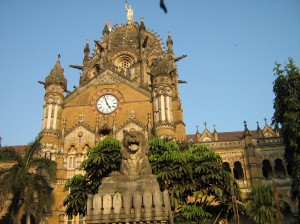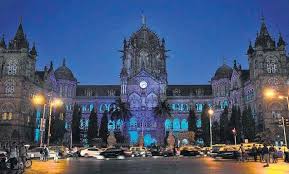 Chhatrapati Shivaji Terminus (CST), formerly Victoria Terminus (VT), is a UNESCO World Heritage Site and an historic railway station in Mumbai Maharashtra, India which serves as the headquarters of the Central Railways. Designed by Frederick William Stevens with influences from Victorian Italianate Gothic Revival architecture and traditional Mughal buildings, the station was built in 1887 in the Bori Bunder area of Mumbai to commemorate the Golden Jubilee of Queen Victoria. The new railway station was built on the location of the Bori Bunder Station and is one of the busiest railway stations in India, serving as a terminal for both long-distance trains and commuter trains of the Mumbai Suburban Railway. The station’s name was changed to its present one in March 1996 and it is now known simply as CST (or CSTM).
Chhatrapati Shivaji Terminus (CST), formerly Victoria Terminus (VT), is a UNESCO World Heritage Site and an historic railway station in Mumbai Maharashtra, India which serves as the headquarters of the Central Railways. Designed by Frederick William Stevens with influences from Victorian Italianate Gothic Revival architecture and traditional Mughal buildings, the station was built in 1887 in the Bori Bunder area of Mumbai to commemorate the Golden Jubilee of Queen Victoria. The new railway station was built on the location of the Bori Bunder Station and is one of the busiest railway stations in India, serving as a terminal for both long-distance trains and commuter trains of the Mumbai Suburban Railway. The station’s name was changed to its present one in March 1996 and it is now known simply as CST (or CSTM).
Mumbai is the entertainment and commercial capital of India. Previously known as Bombay, the city is the capital of the western state of Maharashtra. It enjoys a moderate climate through the year, has the Arabian Sea on the western side and houses the ‘Bollywood’, the film industry of India. Being a major entertainment and commercial hub, the city is visited by lakhs of passengers daily. Some of these are daily commuters coming from the suburbs, while the others are coming here to fulfill their dreams. The Chhatrapati Shivaji Terminus, the railway station of Mumbai is better known as the VT station. Earlier known as the Victoria Terminus, the railway station serves as the Central Railway’s headquarters.
The Mumbai railway station that is the VT station was built in the year 1888, by the Government of India. It was built on the lines of the St. Pancras station in London. Built to honor the Queen Victoria, the railway station was renamed as Chhatrapati Shivaji Terminus in the year 1996. The railway station is a perfect blend of Gothic Revival and traditional architecture of India, displaying ornamental railings, grills and balustrades of brass and iron, woodcarvings and tiles
Bori Bunder (alternatively “Bori Bandar”) was one of the areas along the Eastern shore line of Mumbai, India which was used as a storehouse for goods imported and exported from Mumbai. In the area’s name, ‘Bori’ means sack and ‘Bandar’ means port or haven (in Persian); So Bori Bunder literally means a place where sacks are stored. In the 1850s, the Great Indian Peninsular Railway built its railway terminus in this area and the station took its name as Bori Bunder. On 16 April 1853 the Great Indian Peninsula Railway operated the historic first passenger train in India from Bori Bunder to Thane covering a distance of 34 km (21 mi), formally heralding the birth of the Indian Railways. The train between Bori Bunder and Thane took 57 minutes at a distance of 35 km (22 mi) apart.
 Opening and growth as Victoria & Bombay Terminus:
Opening and growth as Victoria & Bombay Terminus:
Chhatrapati Shivaji Terminus
The station took ten years to complete,the longest for any building of that era in Bombay. This famous architectural landmark in a Gothic-revival style was built as the headquarters of the Great Indian Peninsular Railway. Since then, the station came to be known as Bombay VT.(Railway code-BBVT)
Originally intended only to house the main station and the administrative offices of the Great Indian Peninsula Railway, a number of ancillary buildings have been added subsequently, all designed so as to harmonise with the main structure. The original platforms were from 1-9. As the Harbour line was being extended from its previous terminus at Dockyard road to VT, to prevent congestion, a new mainline concourse with platforms 10-13 to the east of the existing suburban concourse was constructed, to handle main line traffic was erected in 1929. The original building is still in use to handle suburban traffic and is used by over three million commuters daily. It is also the administrative headquarters of the Central Railway.
In 1996, the Minister of Railways, Suresh Kalmadi, changed the name of the station to Chhatrapati Shivaji Terminus in honour of Great King Chhatrapati Shivaji, founder of the Maratha Empire.
In 2008, the station was featured prominently in the Academy Award winning film, Slumdog Millionaire. In 1956, the station was also featured in the film C.I.D. during the song ‘Yei Hai Bombay Meri Jaan’
CST has 18 bay platforms: 7 are for local suburban trains on the west side of the station and 11 are for long distance out-station trains on the east side of the station. Platforms 1-13 open directly into the concourse on the South-side. The newer Platforms 14-18 are located in Carnac bunder(North-east side) with a covered pathway from the bay ends of the platforms to the concourse.
Platforms 1-2 handle 9 coach Harbour line trains, Platforms 3-6 handle 12 coach Main line trains and Platform 7 handles both 12 & 15 coach trains. All suburban platforms are aligned in such a manner that each local train discharges passengers on either side. Plans to extend Harbour line platforms to accommodate 12 coach trains has been sactioned and work will commence after the construction of a stabling yard for 12 coach trains between Vadala road and Sewri.
Platforms 8-16 handles Out-station trains. Platform 8-9 handles <=17 coach trains. Platform 10-11 & Platform 12-13 handles <=19 coach trains. Platform 14-15 handles <=24 coach trains; Platform 16-17 & Platform 18 handles <=26 coach trains. The Railway ministry sanctioned the extension of Platforms 10-13 to accommodate 24 coach trains in 2015 Railway budget
 Bearing the station code of CSTM, the Mumbai railway station provides excellent passenger and terminal facilities. It has the retiring rooms, waiting rooms, dormitories, refreshment rooms, reservation offices, cloakroom, dining areas and drinking water facilities. Besides these, there are other facilities like the public call booths, ATMs, shopping areas and cafes.
Bearing the station code of CSTM, the Mumbai railway station provides excellent passenger and terminal facilities. It has the retiring rooms, waiting rooms, dormitories, refreshment rooms, reservation offices, cloakroom, dining areas and drinking water facilities. Besides these, there are other facilities like the public call booths, ATMs, shopping areas and cafes.
The Mumbai railway station has an historic importance as it was built during the British Raj and named to honor the Queen Victoria. It has been declared a heritage site under the UNESCO world heritage sites. The building of the railway station has some majestic domes, turrets and such grandeur that no one can remain immune to the awe that it creates.
Besides serving as the major link between the western parts with the rest of India, the Mumbai railway station also serves as a link to the suburban areas of Mumbai as well. Mumbai stands joined due to the suburban railways that bring commuters to the main station daily from suburbs like Kalyan, Thane, Panvel, Khapoli, Churchgate and Dhanau etc. The Mumbai railway station is not majestic for its structure, but also for the magnitude of trains and passengers that it handles daily.
